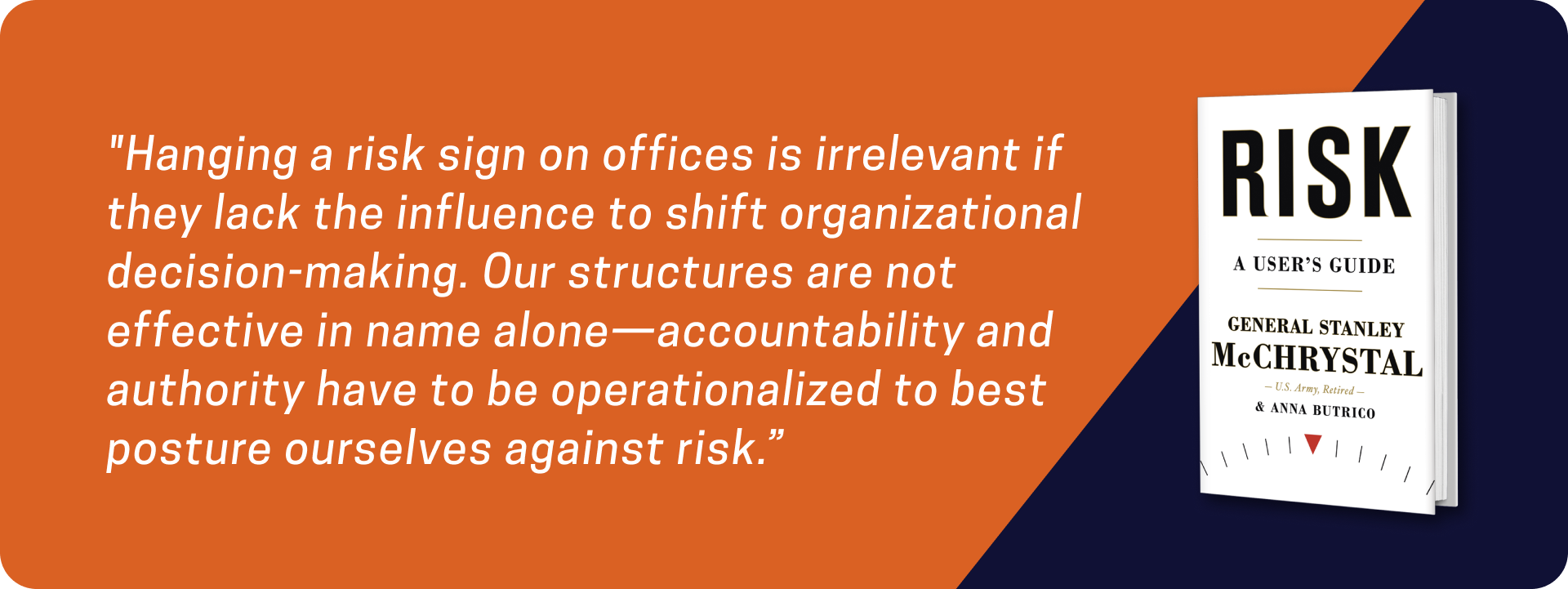It is startlingly clear that with the emergence of ChatGPT, Google’s Bard, Microsoft’s CoPilot, and a litany of other new services backed by generative AI, things are moving fast, and if we’re being honest, even faster than many could have predicted a year ago when OpenAI’s ChatGPT was first made available to the public, igniting a frenzied response and rapid adoption – often with little forethought.
As the Chief Information Officer at McChrystal Group, I've seen firsthand the evolution of AI’s adoption and integration within organizations, with results that swing from astounding to abysmal. Every corner of the business world is grappling with how to harness AI's potential while ensuring control and security.
It's tempting to measure ourselves against others, to ask if we're "ahead or behind" in the AI race. But this framing misses the point. AI isn't just a technological advancement; it's a societal transformation that touches every facet of our lives, from education to healthcare, and, of course, how we work.
So, instead of comparing ourselves to competitors, we should be asking a more fundamental question: Are we in control of AI's potential, or is it already running rampant within our organization, waiting for us to catch up? If you and your leadership team are not sure about the answer to that question, consider these questions:
Do we have a strategy that conveys how our organization will capitalize on AI benefits while minimizing the associated risks?
Do we trust our people to operate according to that strategic plan as they utilize AI?
How will AI impact our organizational culture?
The Start Point: Aligning AI to the Existing Strategy
The availability of out-of-the-box AI tools has significantly simplified the AI adoption process, making AI more accessible to organizations. While that poses many opportunities, it also creates risk. Our data, taken from survey responses from more than 10,000 employees across more than 100 organizations, show less than 40% believe their organization has the necessary technology in place to operate effectively. This statistic highlights that simply making a technological investment is not sufficient; the organization needs to create a plan and clearly communicate how employees will leverage the technology to enhance operations. It's essential for organizations to anchor any investment in an AI initiative within the existing business strategy and processes, and then clearly communicate that to all employees.
This requires focused effort. Organizations can start by thinking about where AI can enhance individual productivity to help improve the organization’s internal operations. Efficiency has long been a driving force for organizations, and AI offers the promise of taking it to unprecedented heights. Automation is the key, and AI is the tool that makes it all possible. However, the catch here is that AI implementation requires a solid strategy, not just a superficial adoption to follow the trends.
A team familiar with the organizational strategy and AI capabilities should review the strategic plan and understand how AI can streamline operations, improve work quality, and ultimately help achieve stated operational objectives. Consider a scenario involving a marketing professional. By automating their routine tasks that are necessary but don’t create a competitive advantage, the employee can instead focus on creativity and problem-solving — key skills that will provide a competitive advantage and won’t be made obsolete by automation and AI.
After focusing on internal capabilities for AI, the team should also consider how AI enhances the strategy by creating industry-specific applications that can have an impact on the bottom line. That same team should identify evidence-based industry-specific challenges or opportunities to determine where AI products and solutions can make a substantial impact. This level of intentionality will help focus and equip teams with the right AI technology, security standards, process controls, and skillsets before embarking on an AI initiative.
Trust But Train: The Technology and the People
Determining, documenting, and communicating how your organization will integrate AI with its existing strategic plan is an important step, but most strategies read well on paper and fail in execution. Once AI is aligned to the strategic plan, ask yourself, “How can I best equip my team to use these tools as intended to achieve our objectives?” It’s not just about the new technology; it’s about change management and making sure everyone is prepared to succeed when the new technology is implemented.
When deciding whether to trust another person, the most fundamental components a person observes are competency, benevolence, and reliability. Some of those same fundamentals apply to trusting technology. Leaders need to trust the technology’s capability and reliability, including the security and process controls in place to manage identified risks. If designed and implemented thoughtfully, these tend to be consistent. The more dynamic and challenging component of trusting technology is trusting the people who use it.
Your organization is undoubtedly filled with talented technologists who might already be using AI tools and getting real results. But there are also those who don’t know what they are doing and could put your organization at risk. There are headlines every week about employees accidentally and unknowingly releasing proprietary information by misusing AI.
There are differing levels of risk, of course. For instance, in your organization, you may trust teams to experiment with AI tools, like ChatGPT, after establishing the proper security settings. However, allowing employees to start sending AI-generated emails or creating reports without any prior communication or training would be an ill-advised risk.
In addition to establishing governance and security protocols, all employees using AI must be appropriately trained. AI adoption and success come down to mastering a set of key capabilities in the right combinations — not only in data and AI, but also in organizational strategy, talent and culture. Understanding how to execute the tactical steps to use this new technology while also considering all of these broader factors is not something leaders can expect employees to adopt intuitively. In addition to investing in the AI capability, the organization needs to invest in developing and deploying a thoughtful training program.

Cultural and Behavioral Shifts
AI isn't solely a technological adoption; it necessitates cultural and behavioral shifts within the organization. The challenge often arises from unpreparedness, which can be attributed to poor leadership and a lack of effective coaching. To leverage AI effectively, organizations must foster an environment that encourages AI adoption, nurtures behavioral change, and maintains a focus on driving productivity and quality.
A leadership team’s email telling their organization that we trust them to use AI tools might be well-intentioned, but this alone will not drive behavioral and attitude changes. Even technologically competent teams require the right cultural and behavioral support when dealing with AI.
Take the same scenario involving a marketing professional leveraging AI to create more time for creative thinking and problem-solving. That professional’s manager initiates a conversation with them about where they see the greatest inefficiencies. The marketing professional shares that they spend significant time each month drafting and distributing an internal organizational newsletter. This could be an area for the manager to encourage the professional to experiment with AI while providing guidance and boundaries. For example, the manager could:
Encourage use of AI: The manager recommends that rather than spending hours getting started on a draft communication, the professional leverage AI to draft the communication for them.
Focus time reviewing AI information: The manager guides that in refining and reviewing the AI-prepared communication, the professional should focus their review attention on accuracy and language applicability so that the message lands within the context of their organization.
Reinforce safety and security policies: The manager ensures the marketing professional understands which personal and proprietary information should not be included in their AI prompts, so as not to divulge sensitive information about the organization or its employees to the public domain.
Broker relationships to facilitate effective AI use: The manager sends a direct message connecting this marketing professional to someone in the organization well versed in AI to broker a connection that offers the marketing professional technically specific guidance and thought partnership.
Inform relevant technical experts of inefficiencies and AI needs within the organization: Finally, the manager should act as an information funnel and ensure relevant technical experts know which inefficiencies demand the greatest amount of time from employees, to see if there are AI solutions that can be implemented at-scale to support organizational productivity.
This is the people portion of the “People, Process, Technology” framework that is the foundation of every organization. It’s paramount that leaders get their people on the same page first and foremost before unleashing the most impactful technological advancement since the internet on their workforce.
Effective leadership involves creating policies, fostering a sense of shared consciousness, and coaching employees on AI adoption, just like leaders have done for decades in other aspects of management.
AI Implementation: In or Out of Control?
Following the release of ChatGPT to the public, 2023 quickly became the year of AI, and rightfully so. Roughly a year later, organizations find themselves at a crossroads. The question is no longer whether to adopt AI — it’s how to do it effectively. We've moved past the point of being "ahead" or "behind" in the AI game; it's about being in control or out of control.
Many leaders grapple with the anxiety of not having control over AI initiatives. They face the challenge of aligning their organizational goals with their AI capabilities. AI adoption requires a critical examination of existing processes, data governance, and ultimately comes down to effective change management.
With Pandora's Box of AI already open, organizations must find ways to focus, guide, and harness its capabilities. The key to AI success lies in combining technical proficiency with behavioral and cultural readiness, ensuring AI becomes a catalyst for organizational excellence.
As the AI journey unfolds, remember that the real questions often lie in everyday scenarios such as how to trust AI tools, how employees and teams can verify its outputs, and how to manage AI adoption starting at the ground level. These may not be the most glamorous aspects of AI, but they are the ones that will drive real success in your AI initiatives.
Want to know how McChrystal Group help drive your team's effectiveness? Please contact our team to learn more.



